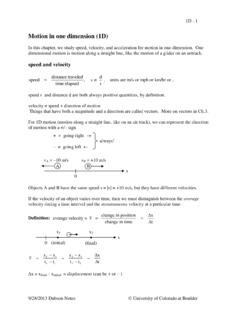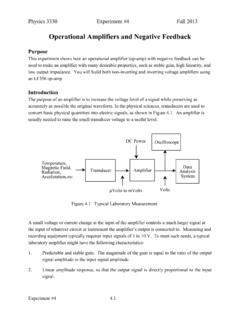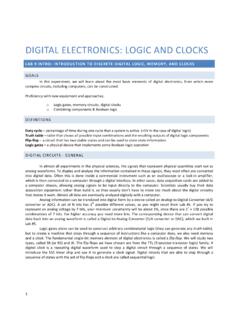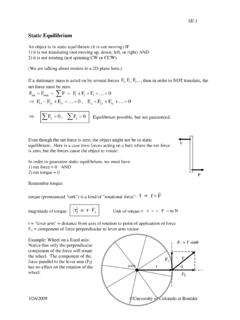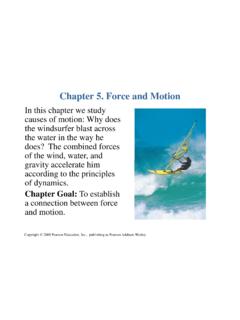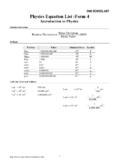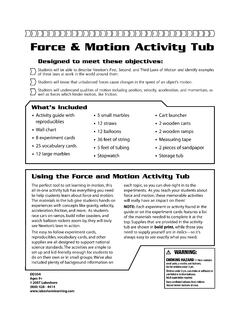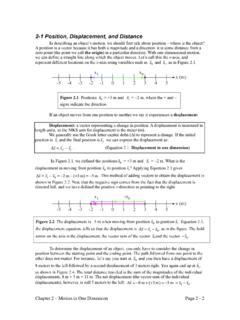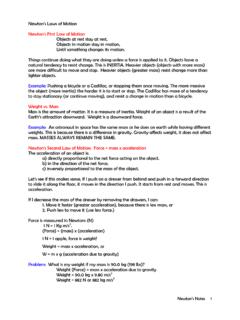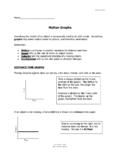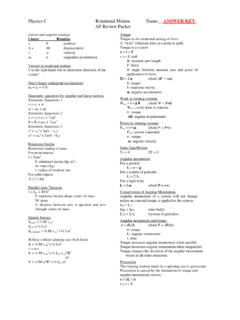Transcription of Rotational Motion - Physics
1 R-1 11/8/2013 University of Colorado at Boulder Rotational Motion We are going to consider the Motion of a rigid body about a fixed axis of rotation. The angle of rotation is measured in radians: s(rads) (dimensionless)r Notice that for a given angle , the ratio s/r is independent of the size of the circle. Example: How many radians in 180o? Circumference C = 2 r rs =radsrr rads = 180o, 1 rad = Angle of a rigid object is measured relative to some reference orientation, just like 1D position x is measured relative to some reference position (the origin). Angle is the " Rotational position". Like position x in 1D, Rotational position has a sign convention. Positive angles are CCW (counter-clockwise). Definition of angular velocity : d = (rad/s)dtt , ( like dxxv , v dtt ) units rad = s In 1D, velocity v has a sign (+ or ) depending on direction.
2 Likewise, for fixed-axis rotation, has a sign, depending on the sense of rotation. More generally, when the axis is not fixed, we define the vector angular velocity with direction = the direction of the axis + "right hand rule". Curl fingers of right hand around rotation, thumb points in direction of vector. v : (+) ( ) (+) ( ) s r s r s = r r x 0 x + x R-2 11/8/2013 University of Colorado at Boulder For Rotational Motion , there is a relation between tangential velocity v ( velocity along the rim) and angular velocity . s s = r r , rsv = = rtt v = r Definition of angular acceleration : 2d (rad/s )dtt , ( like dvva a dtt ,) Units: 2rad = s = rate at which is changing. = constant = 0 speed v along rim = constant = r Equations for constant : Recall from Chapter 2: We defined dxdvv = , a = dtdt , and then showed that, if a = constant, 0212002200v = va txxv ta tvv2 a xx () Now, in Chapter 10, we define dd = , = dtdt.
3 So, if = constant, 0212002200 = ttt2 () Same equations, just different symbols. Example: Fast spinning wheel with 0 = 50 rad/s ( 0 = 2 f f 8 rev/s ). Apply brake and wheel slows at = 10 rad/s. How many revolutions before the wheel stops? Use 2202 , final = 0 222005002125 rad22 10 () 1 rev125 rad19 9 rev2 rad . s in time t r R-3 11/8/2013 University of Colorado at Boulder Definition of tangential acceleration atan = rate at which speed v along rim is changing drdvda =rdtdtdt tan() atan = r atan is different than the radial or centripetal acceleration 2rvar ar is due to change in direction of velocity v atan is due to change in magnitude of velocity , speed v atan and ar are the tangential and radial components of the acceleration vector a. 22tanr| a |aaa Angular velocity also sometimes called angular frequency.
4 Difference between angular velocity and frequency f: # radianssec , # revolutionsfsec T = period = time for one complete revolution (or cycle or rev) 2 rad2TT , 1 rev1fTT 2f Units of frequency f = rev/s = hertz (Hz) . Units of angular velocity = rad /s = s-1 Example: An old vinyl record disk with radius r = 6 in = cm is spinning at rpm (revolutions per minute). What is the period T? 33 3 rev33 3 rev60 s60 33 3 s1 80 s/rev1min60 s33 3 rev1rev ..(/.).. period T = s What is the frequency f ? f = 1 / T = 1 rev / ( s) = Hz What is the angular velocity ? 12f20 555 s3 49 rad s (.)./ atan a ar R-4 11/8/2013 University of Colorado at Boulder What is the speed v of a bug hanging on to the rim of the disk? v = r = ( cm)( s-1) = cm/s What is the angular acceleration of the bug? = 0 , since = constant What is the magnitude of the acceleration of the bug?
5 The acceleration has only a radial component ar , since the tangential acceleration atan = r = 0. a = 222r0 530 m/sva1 84 m/sr0 152 m(.).. (about g's) For every quantity in linear (1D translational) Motion , there is corresponding quantity in Rotational Motion : Translation Rotation x dxvdt d = dt dvadt d = dt F (?) M (?) F = Ma (?) = (?) KE = (1/2) m v2 KE = (1/2) (?) 2 The Rotational analogue of force is torque. Force F causes acceleration a Torque causes angular acceleration The torque (pronounced "tork") is a kind of " Rotational force". magnitude of torque: r Fr Fsin r Fm N r = "lever arm" = distance from axis to point of application of force F = component of force perpendicular to lever arm axis r F F F = F sin F|| R-5 11/8/2013 University of Colorado at Boulder Example: Wheel on a fixed axis: Notice that only the perpendicular component of the force F will rotate the wheel.
6 The component of the force parallel to the lever arm (F||) has no effect on the rotation of the wheel. If you want to easily rotate an object about an axis, you want a large lever arm r and a large perpendicular force F : Example: Pull on a door handle a distance r = m from the hinge with a force of magnitude F = 20 N at an angle = 30o from the plane of the door, like so: = r F = r F sin = ( m)(20 N)(sin 30o) = m N For fixed axis, torque has a sign (+ or ) : Positive torque causes counter-clockwise CCW rotation. Negative torque causes clockwise (CW) rotation. If several torques are applied, the net torque causes angular acceleration: net Aside: Torque, like force, is a vector quantity. Torque has a direction. Definition of vector torque : rF = cross product of r and F: "r cross F" Vector Math interlude: The cross-product of two vectors is a third vector A BC defined like this: The magnitude of AB is A B sin.
7 The direction of AB is the direction perpendicular to the plane defined by the vectors A and B plus right-hand-rule. (Curl fingers from first vector A to second vector B, thumb points in direction of AB r F = r F Another example: a Pulley axis no good! (r = 0) bad better best no good! (F = 0) + hinge F F r R-6 11/8/2013 University of Colorado at Boulder To see the relation between torque and angular acceleration , consider a mass m at the end of light rod of length r, pivoting on an axis like so: Apply a force F to the mass, keeping the force perpendicular to the lever arm r. acceleration atan = r Apply Fnet = m a, along the tangential direction: F = m atan = m r Multiply both sides by r ( to get torque in the game ): r F = (m r 2) Define "moment of inertia" = I = m r 2 = I ( like F = m a ) Can generalize definition of I: Definition of moment of inertia of an extended object about an axis of rotation: 222i i1 12 2iIm rm rm r.)
8 Examples: 2 small masses on rods of length r: I = 2 m r2 axis r m A B A B axis F F axis ri m i axis m m r r R-7 11/8/2013 University of Colorado at Boulder A hoop of total mass M, radius R, with axis through the center, has Ihoop = M R2 222i iiiiIm rm RM R (since ri = R for all i ) In detail: 2222221 12 23 312322123Im rm rm rm Rm Rm RmmmRMR() A solid disk of mass M, radius R, with axis through the center: Idisk = (1/2) MR2 (need to do integral to prove this) See Appendix for I s of various shapes. Moment of inertia I is " Rotational mass". Big I hard to get rotating ( like Big M hard to get moving ) If I is big, need a big torque to produce angular acceleration according to net = I ( like Fnet = m a ) Example: Apply a force F to a pulley consisting of solid disk of radius R, mass M. = ?
9 212I2FR FMRMR Parallel Axis Theorem Relates Icm (axis through center-of-mass) to I some other axis: I = Icm + M d2 (See proof in appendix.) Example: Rod of length L, mass M 2CM1IM R12 , d = L/2 2222end axisCM111 IIM dM LM LM L1243 R mi R mass M d rod mass M length L axis here ( I ) axis here ( Icm ) R F R-8 11/8/2013 University of Colorado at Boulder Rotational Kinetic Energy How much KE in a rotating object? Answer: 21rot2 KEI ( like 21trans2 KEm v ) Proof: 21toti i2iKE( m v ) iivr ,vr 2222111iii i222iiKE( mr )m rI How much KE in a rolling wheel? The formula v = r is true for a wheel spinning about a fixed axis, where v is speed of points on rim. A similar formulas vCM = r works for a wheel rolling on the ground. Two very different situations, different v s: v = speed of rim vs. vcm = speed of axis.
10 But v = r true for both. To see why same formula works for both, look at situation from the bicyclist's point of view: axis ri m i v vcm = center-of-mass velocity = r axis stationary: v = r v v point touching ground instantaneously at rest v axis stationary, ground moving v R-9 11/8/2013 University of Colorado at Boulder Rolling KE: Rolling wheel is simultaneously translating and rotating: 2211tot22 KEM vI (v = Vcm ) (See proof in appendix.) Conservation of energy problem with rolling Motion : A sphere, a hoop, and a cylinder, each with mass M and radius R, all start from rest at the top of an inclined plane and roll down to the bottom. Which object reaches the bottom first? Apply Conservation of Energy to determine vfinal. Largest vfinal will be the winner. iiff221122KE rotKE transKEPEKEPE0 MghM vI0 Value of moment of inertia I depends on the shape of the rolling thing: Idisk = (1/2)M R2 , Ihoop = M R2 , Isphere = (2 /5)M R2 (Computing coefficient requires integral.)
